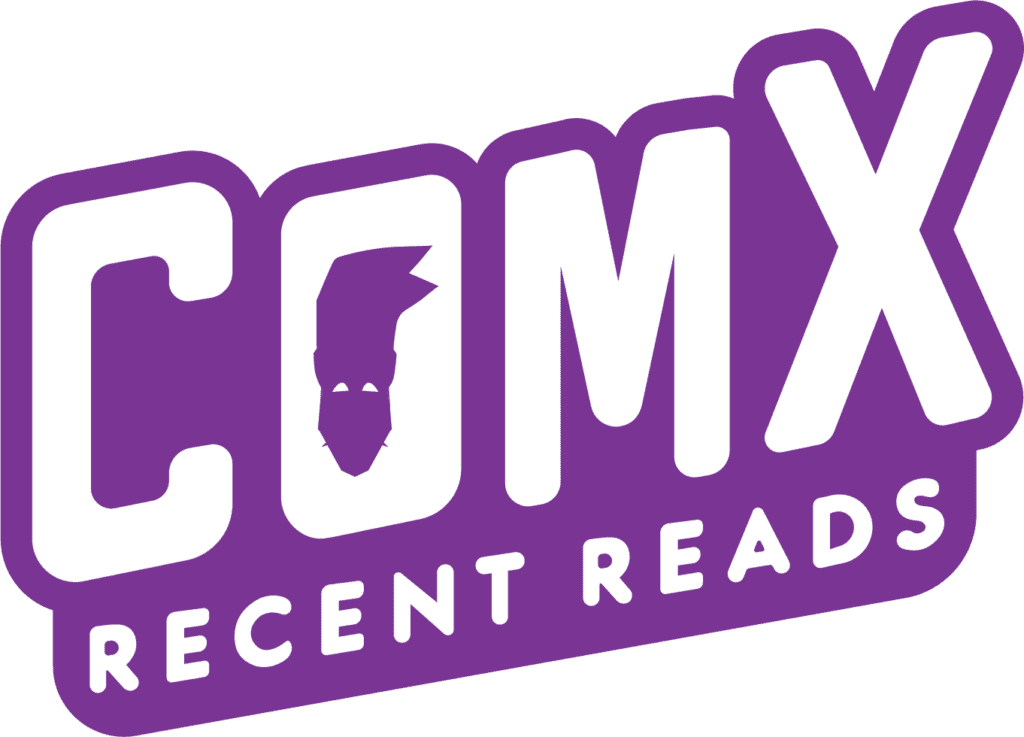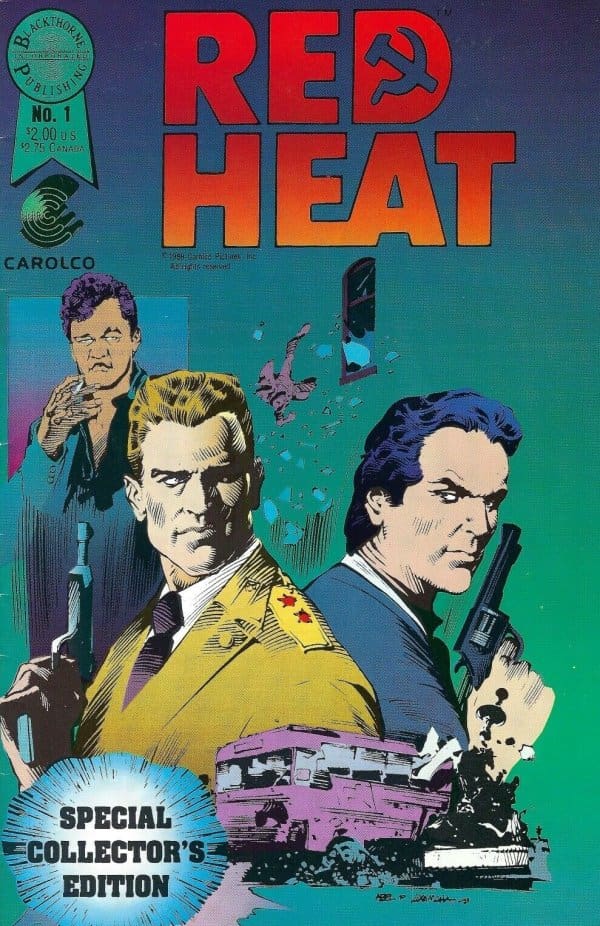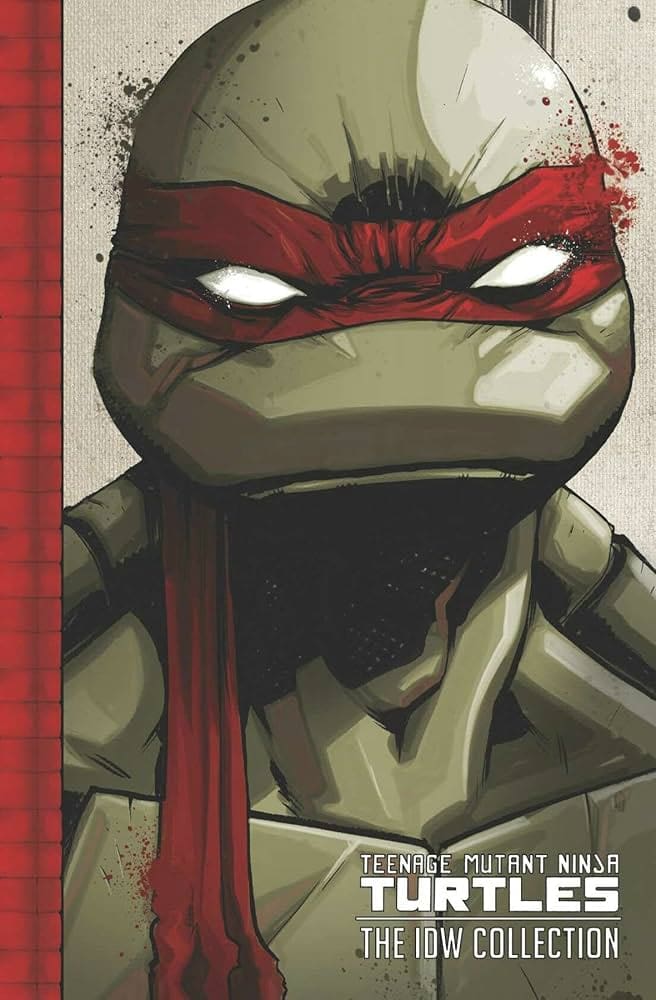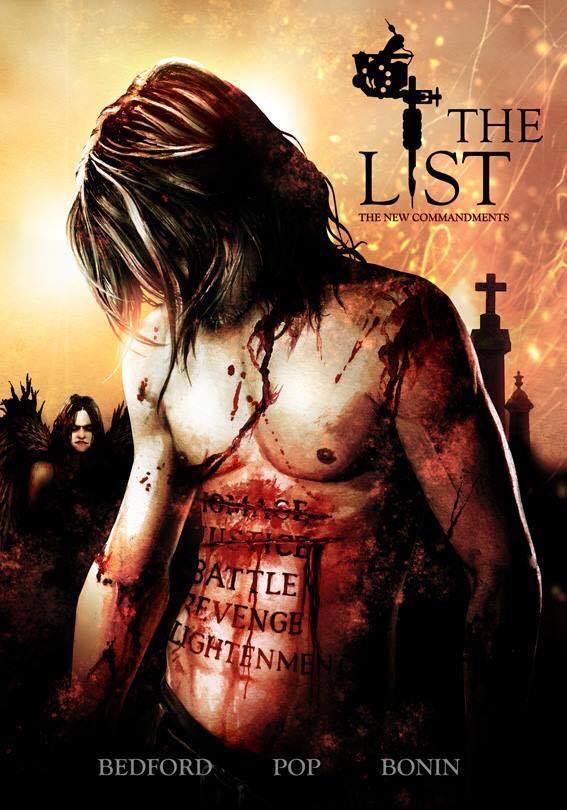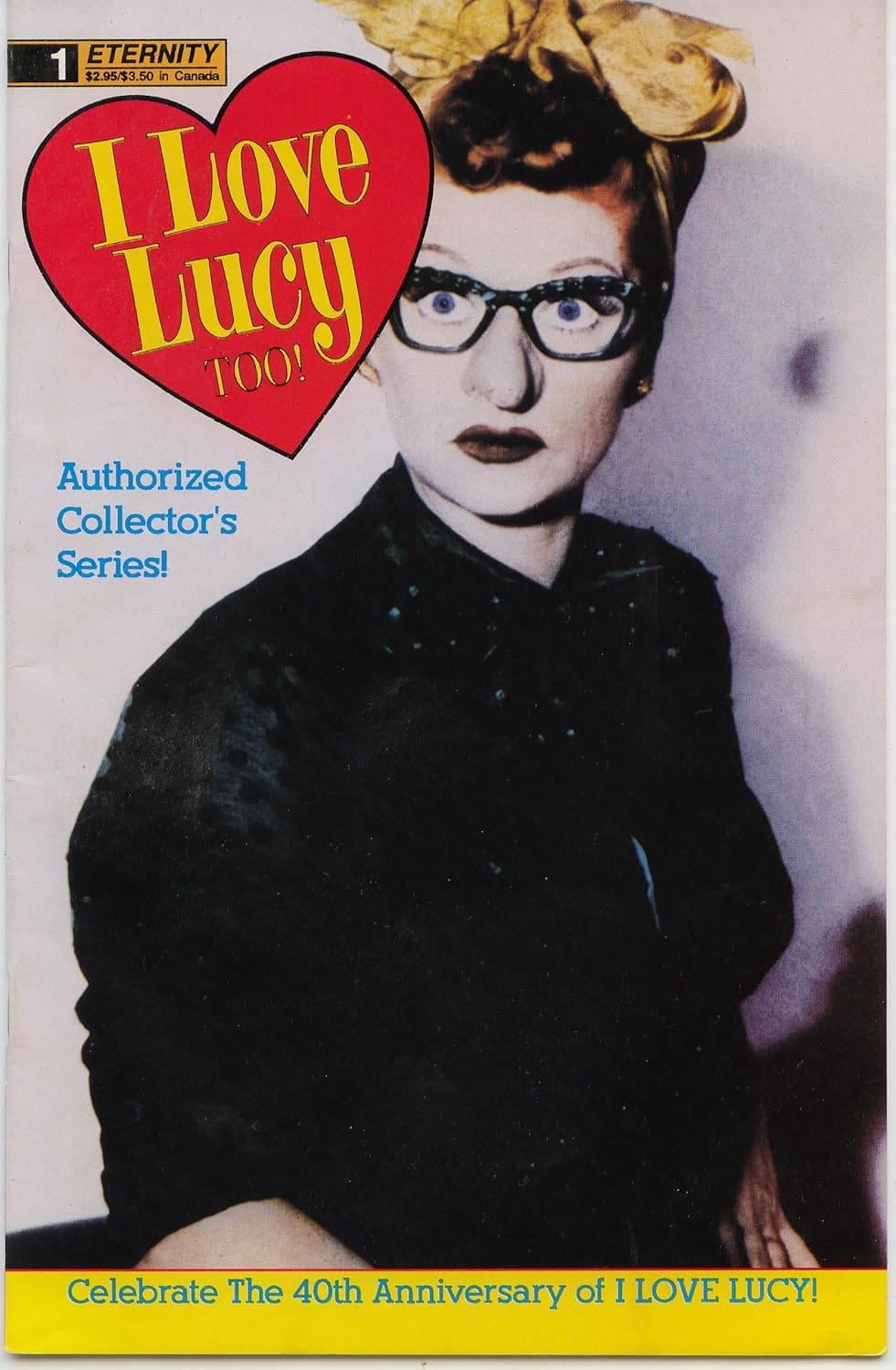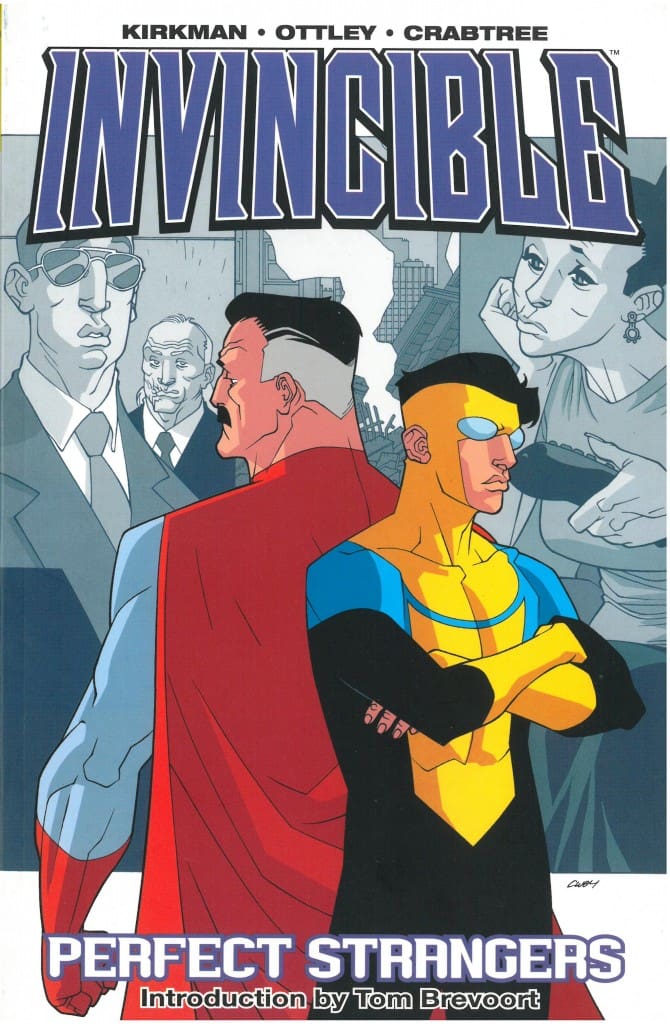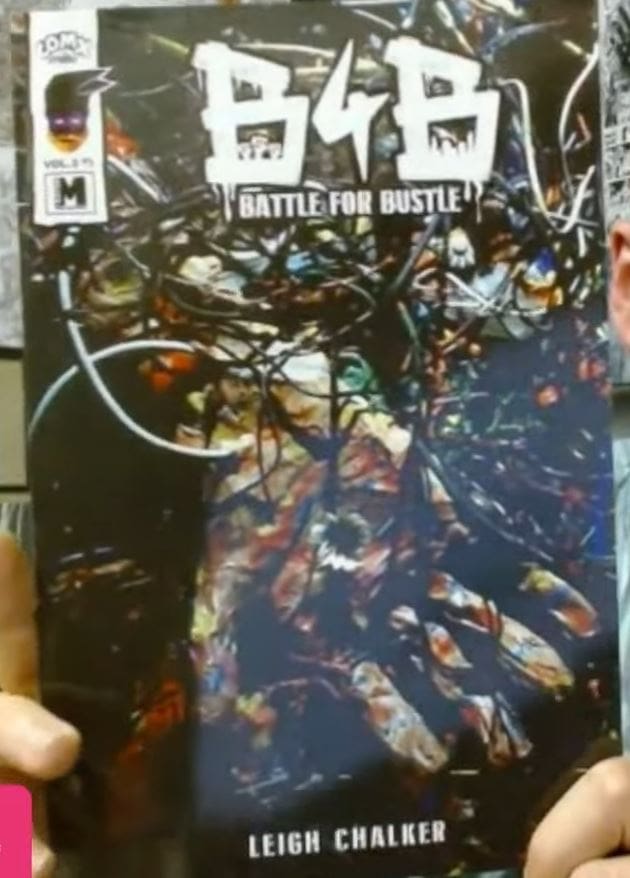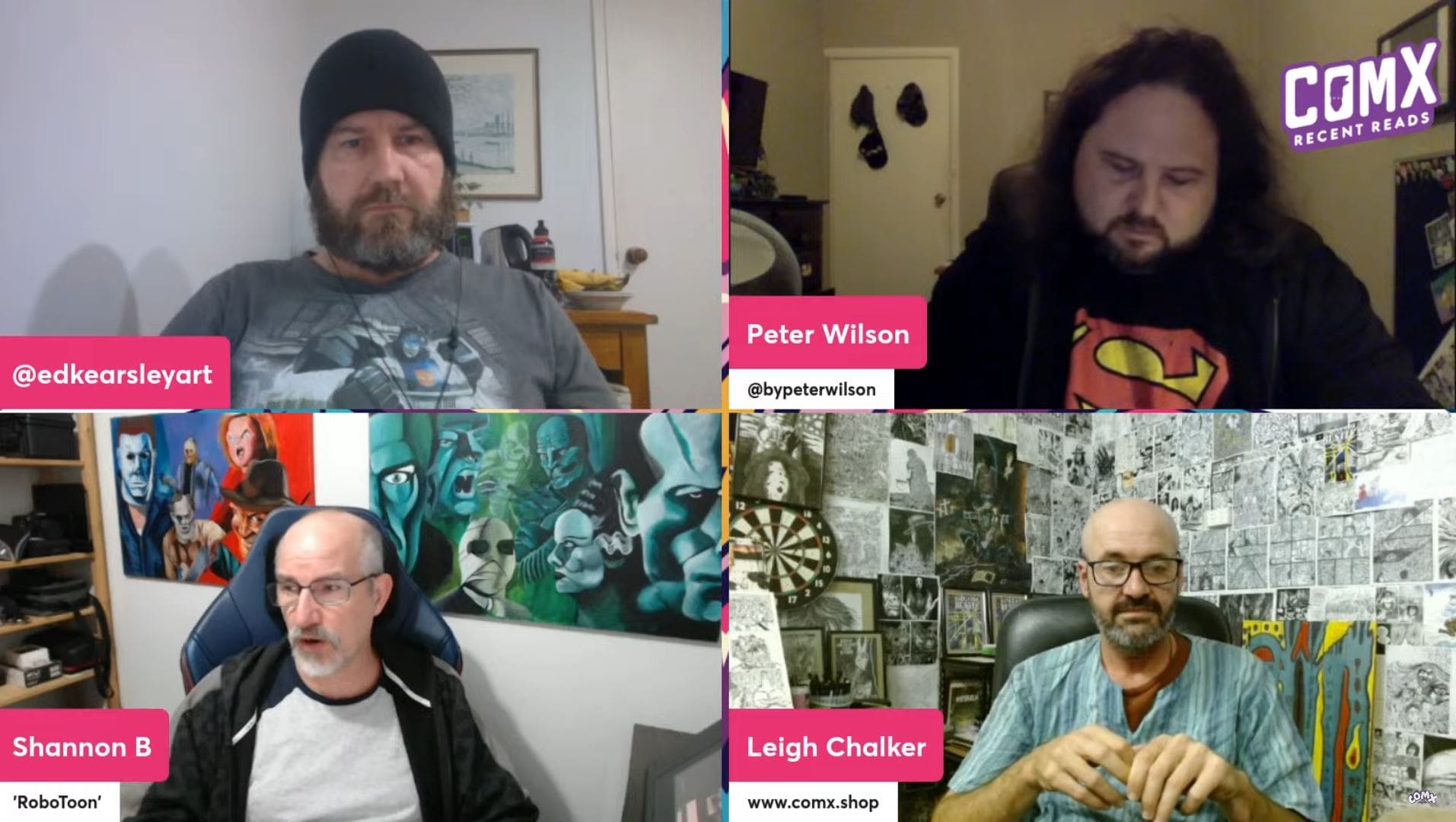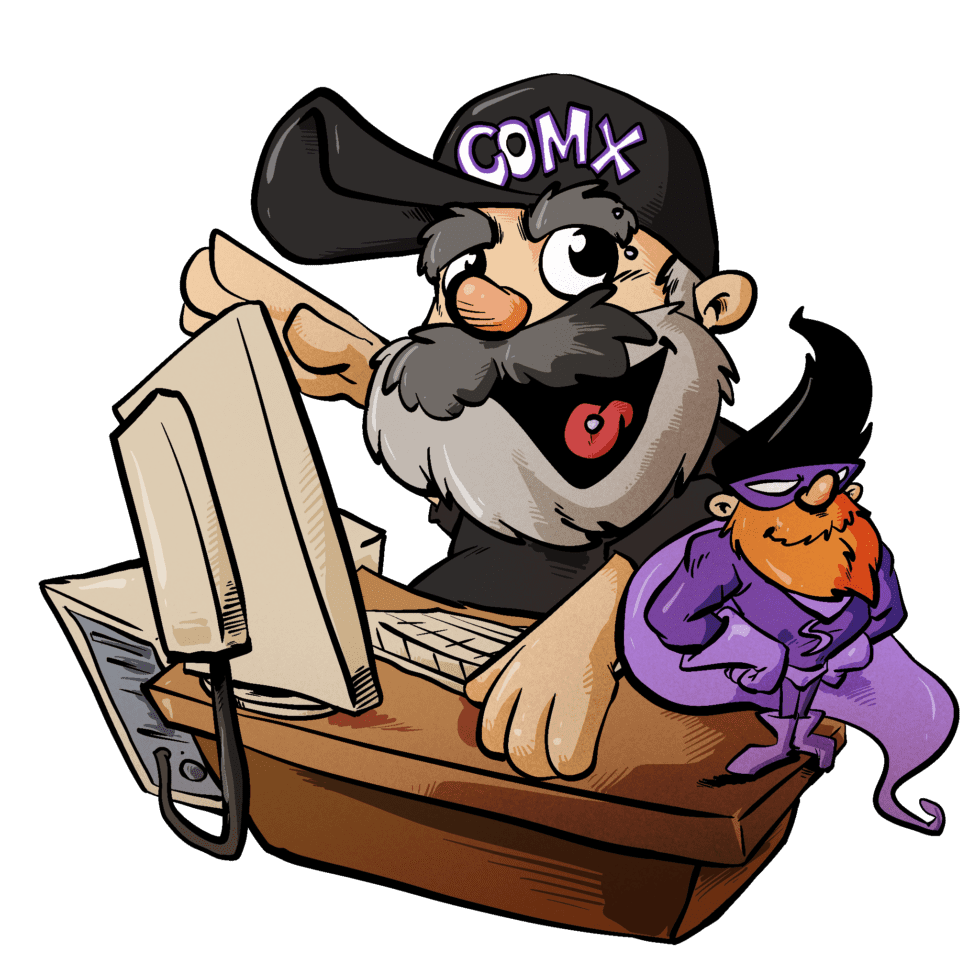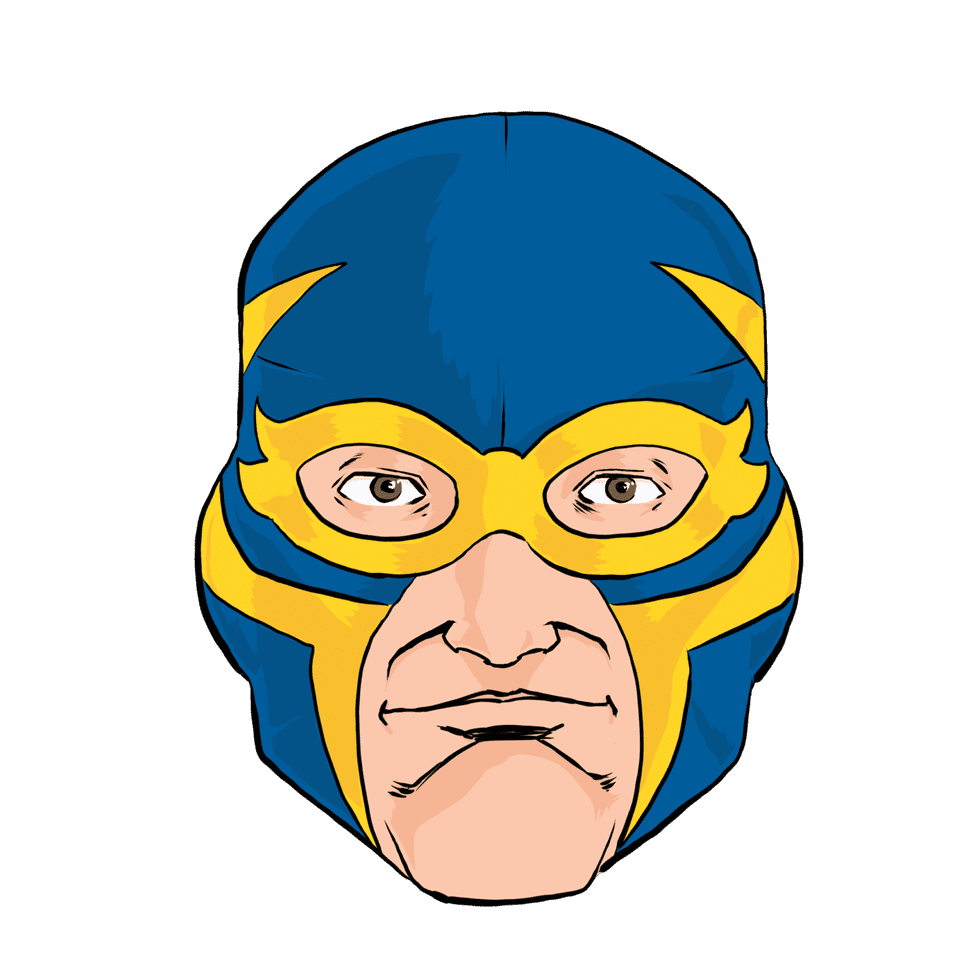Ed Kearsley (00:01):
Hello everyone and welcome to Comex recent reads. I have your host, ed Kiley and tonight joined by Peter Wilson, Shannon Browning and Luke Joer. And we’re going to talk about some comic books that we’ve read recently. So we’ll just quickly go through and get everyone to tell us what book they’re going to be talking about and the creative team of said book. So we’ll start with Peter at the top.
Peter Wilson (00:36):
This is volume one of the IDW Collection, ninja Turtles. Kevin Eastman, the original creator, was heavily involved. There’s quite a big rolling team on this though. A lot of different artists and writers.
Ed Kearsley (00:51):
Yeah,
Peter Wilson (00:52):
But very cool.
Ed Kearsley (00:54):
Excellent. All right, we’ll go to Shannon. What book have you brought in today? And
Shannon Browning (01:00):
I read it digitally, but I am getting a bit mainstream at the moment. I’m reading DC’s Absolute Power Issue One, which is their big crossover for all the titles for this year, written by Mark Wade, who very famous for DC work. He worked on The Flash years ago. He wrote Kingdom Come. He wrote a wonderful Superman origin story who subtitle I can’t remember at the moment. Birthright that was it. And Art is by Dan Mora, who’s most recently been working on, I took my notes. He’s been working on World’s Finest and the ongoing Shazam title as well.
Ed Kearsley (01:49):
Cool. All Lee, what you got and who did it?
Leigh Chalker (01:54):
Right. I’m going to do an Australian comic book called Graphic Novel, but it was a series, it’s called The List. It’s by Paul Bedford, Henry Pop and Tom Bonn. So I will go into as much detail as is family friendly as I can from this title. Yeah, so that’s what I’m doing.
Ed Kearsley (02:22):
Cool. And I would be looking at Red Heat and that is by John Stevenson and Abelina or Zaina. So that’s what you got to look forward to from me. So now we’ll get into the meat of the programme and we’ll, does anyone want to go first?
Shannon Browning (02:50):
You can
Ed Kearsley (02:52):
Me or I could start off. So I’m actually on holidays if you notice my background’s different than the normal door that you see behind me when I’m doing these shows. I didn’t bring a book or had time to read a book while I was away, so I got this at a Sunday market yesterday. And so I’ve read it and it’s an adaption of the 1988 Arnold Schwarzenegger and from the appearance of the cover Michael Keaton movie actually,
Shannon Browning (03:32):
Sorry, Jim Behi. Jim Behi
Ed Kearsley (03:34):
The famous guy. And the first thing I noticed about it was how good the artwork is. Although none of the likenesses ever of any of the characters that’s supposed to be Schwarzenegger, but it’s really nice like ink work, Russian pen. And I looked up the artist and he’s one of the guys that came over from the Philippines in the seventies, although I’d never heard of him, but Alfred Alo and only Chan and all those guys. So there’s a shot there where Belushi looks like the Walton Goggins.
(04:26)
And so it’s the basic thing of the movie where the Russian gangster shoots Schwarzenegger’s partner in Russia, then he flees to America where he gets caught by the Chicago cops and then he shoots Belushi’s partner and then they track him down. And that’s one of the only likenesses that really worked is the Peter Boyle. Oh yeah. I looked it up to see if it was Peter Boyle and it was because that was the only character that looked like him. And then there’s this really cool bit, let me get to it. So here I’ll go full screen again. And this to me looks like the deadline inking style. It’s like it was running out of time, it’s just smashing the ink in, but it still looks really good. It’s really frenetic. It’s a bus. It
Shannon Browning (05:29):
Still reads perfectly, doesn’t it?
Ed Kearsley (05:31):
Yeah, it’s a bus chase scene, but the faces are barely drawn. You can see in the corner there. I think so, yeah. Whereas basically the gangster goes to America and then they team up and they hate each other. The wise Kraken American guy with the stiff robotic Russian guy as a robot and also the ads are really cool. There’s ad for Werewolf, which I think is that TV show that was on in the nineties over here. Oh wow. And oh and the Rambo in 3D. Awesome. There’s also an ad for this comic in 3D in the back, so the Duck Thorne Publishing obviously had it in with someone in Hollywood, someone at a movie studio to get the licencing and they had someone who could do 3D treatments to their comics as well. And yeah, that’s about it for that one. Really interesting. There’s Blackthorn. Yeah, so it came out in 1988, so I’m wondering if they tried to get it in a time with the movie release and stuff and the guy didn’t have much reference. He’s such a good artist, but it doesn’t really look like,
Shannon Browning (07:13):
The funny thing about some of those adaptions that they used to do is they would get the rights to do the comic, but they weren’t given the the likeness rights of the actors in the film. So they weren’t had to find this middle ground of making it look like the character, but not look like the actor. That’s
Ed Kearsley (07:35):
Interesting.
Shannon Browning (07:36):
Yeah, so sometimes they sort of were stuck in this middle ground of make it look like them, but don’t make it look like them. Funny enough I read as well is that Marvel comics doesn’t have the rights to draw Deadpool’s costume, the movie version. I dunno how the hell the legality of that works, but yeah,
Ed Kearsley (08:04):
Because there’s more than one panel where the character looks like Michael Keaton. I also thought it might’ve been because if you’ve been drawing superhero comics and action hero books, it kind of goes against your nature to draw someone who’s got a face like Belushi as the lead in a comic book
Peter Wilson (08:32):
Because
Ed Kearsley (08:34):
They’re either grizzled or handsome.
Shannon Browning (08:42):
Belushi had an interesting face. Let’s be polite and say it that way.
Peter Wilson (08:49):
I know with a lot of adaptations too, the person who’s writing the script will often get an early draught of the script and not the most recent one. So you might get things that deleted scenes or rewrites or sometimes characters get chopped out. I used to read a few novelizations that were adapted from movies and they seem to have that in common.
Shannon Browning (09:12):
Yeah, I remember that as well. I used to love getting the novelizations of films and reading them and yeah, you’d be reading a sequence or a moment and just like, I don’t remember that in the film it was because it was from the original script and not the edited film. Peter, did you ever read the Novelization of Gremlins two?
Peter Wilson (09:31):
Yes, yes I did.
Shannon Browning (09:34):
You know the part in the film, it’s very famous because when the film was in cinemas, the gremlins got into the projection booth and Hulk Hogan sort of saved the day in that and then went the video, the gremlins started messing around with the video itself and doing the shadow puppet stuff. I can’t remember who saved the day with that, but in the Gremlins two novelization, the Gremlins actually got into the writer, the writer’s house locked in in the bathroom, and then the brain gremlins started writing a bit of a sil liqui before the rider could get out and kick him out of the house.
Peter Wilson (10:12):
I don’t remember that. It was a long time ago.
Shannon Browning (10:15):
Yeah, yeah. I was watching a Doco about that recently and someone mentioned it and it reminded me,
Peter Wilson (10:22):
I’m going to have to track that down again now I want to read that.
Leigh Chalker (10:27):
Yeah, they were pretty, movie adaptations were pretty prevalent when I was younger too. Particularly the Return of the Jedi collected one, the two Conan ones, the Barbarian and the Destroyer and the Dune one, which man, there you go. Yeah,
Peter Wilson (10:59):
The pers.
Leigh Chalker (11:01):
Yeah. Yeah. No, I’ve got those tucked away somewhere too. But do you remember the comic book ones? Did you ever see those? They used to get these legendary artists like Bill Sekovich did the June one and it’s like, man, some really beautiful artwork and that I poured over that many, many times and now has a ridiculous price on it. If you want to get it secondhand,
Shannon Browning (11:28):
I
Leigh Chalker (11:28):
Believe it, 200 bucks or something like that, man, for this adaptation. Yeah, yeah, yeah. They were good. Used to be able to get them a comic book shops and you’d have arguments with my dad. They were like $3 in a normal comic was like, you get, you’d be better off buying two comics for that price, but I want this one dad. Arguments within Shoe and Good times. Yeah. Comics were bought regardless, so yeah. But is Red Heat, is that the one where at the start of the movie they have some big fight in, I dunno, like the
Ed Kearsley (12:14):
Bathhouse?
Leigh Chalker (12:15):
Yeah, yeah, man. And they’re all in a sauna and dudes are belting the hell out of each other and the So they
Ed Kearsley (12:23):
Could show off Auntie’s body.
Leigh Chalker (12:25):
Yeah, yeah, yeah. I
Peter Wilson (12:27):
Remember that my then made me turn it off. That seemed, for some reason,
Leigh Chalker (12:34):
Maybe they saw his adaptation of how he was drawn. Man, we better tack on some body here so people don’t get confused.
Ed Kearsley (12:43):
Your dad might not have wanted you to turn into a communist, so trying to save you
Peter Wilson (12:50):
Better than Right song.
Shannon Browning (12:53):
I’m sure every kid that was raised in the eighties just has at least one memory of a parent just running for the TV to turn it off or change the channel because all of a sudden boobs shouldn’t appeared on screen.
Peter Wilson (13:06):
Yeah,
Leigh Chalker (13:07):
Shannon, I’d have to say no, man, I don’t, because I used to watch the majority of my movies with my uncles and they’re about 10 years older than me, mate. So I was, yeah, there was no rushing for the old beta chord mate back in those days. I was possibly traumatised. I don’t remember as much or seeing things I shouldn’t have, but they kept on playing and those dudes introduced me to Alien on Christmas night when everyone was at midnight Mass, and I didn’t go because I faked being asleep, but the punishment was to be introduced to the chest bursting at five years old. You know what I mean? It’s sitting there. Yeah. So probably they were cool dudes in hindsight, so thank you.
Shannon Browning (14:14):
I saw Jaws for the first time when I was five years old, and it was like New Year’s Eve, either I think it was 80, going into 81. Christ that makes me old. But yeah, I remember starting right in front of the tv, the usual thing, lying on your stomach and your head like this and staring up at the screen. And by the end of the movie I was at the other side of the room hiding behind the couch and staring underneath, but still up north.
Peter Wilson (14:42):
Jurassic Park was mine. I remember being sick over school holidays as school holidays started, and I was bedridden for most of it, and my dear old grandpa felt really bad for me, so he snuck out and got the VHS address to show me despite my mother’s wishes that I don’t see it. I remember, I think I watched it three times that day and I still rewatch it at least once a week now, despite nightmares of raptors in my kitchen and Tre barging through my window
Shannon Browning (15:13):
Actually bring it up. What movie gave you the worst nightmares when you kid? What imagery sort of got stuck in your head? I mean, Peter, you just said with the veloc wrap, what about Air Lee, you guys, what do you reckon?
Ed Kearsley (15:28):
I had a few Freddie Krueger dreams when I was a kid, but he was always on my side
Peter Wilson (15:37):
Worrying.
Leigh Chalker (15:43):
There would’ve been a few, but the one that always springs to mind, and it still makes me feel sad, like man, a long time later in the fly, part two, there’s a scene where they experiment on a dog and Oh
Shannon Browning (16:09):
God, I know what you’re talking about. Yeah,
Leigh Chalker (16:11):
Yeah. And later on in the film, the dog comes back and that really broke my heart and that since then, I probably much like a lot of others, I’m a huge animal lover, obviously, and have dogs and have always had dogs. And since that, I’ve never watched that movie again. If I know a movie is going to have a dog or an animal injured in it, regardless, I tend to steer clear of ’em. And if a movie suddenly has an animal that’s injured in it through man’s cruelty and stuff like that, that tends to be the end of the film. And what would you mean? Yeah, so yeah, that really manned. Yeah, that kept me up. I couldn’t sleep that night. I remember I probably would’ve been 11 or 12 at the time too, so that’s lasted with me a very long time, man. Thank you for bringing that up. I thought I’d put it behind me. Be a long ahead.
Shannon Browning (17:21):
I just remember having nightmares about Ed 2 0 9 from Robocop. I wasn’t trying to bring up childhood traumas.
Leigh Chalker (17:27):
Yeah, yeah.
Peter Wilson (17:30):
The way he moved freaked me out in Robocop
Shannon Browning (17:33):
The, which one
Peter Wilson (17:35):
Was Jagged Stop Motion walking.
Ed Kearsley (17:40):
That
Peter Wilson (17:41):
Really threw me, that freaked me out
Shannon Browning (17:44):
Because my sister hired that for me. I can’t remember how old I was. I was like 12, 11 or 12 or something like that. And I was used to watching movies on front that were taped off tv and of course in the eighties the censorship board was archaic. It was insane how much that they cut out of films. So all of a sudden I’m going from things that are almost rated action films to robocop, which is a very heavy R. So that scene with that 2 0 9 at the beginning where he just annihilates that junior executive, that was it. I had to turn the movie off and that freaked me out for ages. I was having nightmares about that for a while,
Leigh Chalker (18:28):
Man. I remember my 70-year-old uncle coming up to visit us in Townsville and my dad decided to get robocop out when it was brand new and my mom and George’s wife ley disappeared, and there was me on a three seater couch between my dad and George, and we loved every minute of it, man. I know it sounds really weird, but when it comes to ridiculous ultra violence in films, it’s what it is to me. It just goes over my head. It’s just all fake and everything. Robocop, man, I’ve watched that a lot. I got to tell you, I like those dystopian futuristic things. And the Robocop too was cool as Man, let’s forget about Robocop three with the ninja and stuff, but Robocop two was pretty good. I enjoyed that immensely, but yeah. Yeah, so there you go, Shannon. We both won’t sleep tonight, mate. Talk to our therapists tomorrow, mate. You know what I mean? Well,
Shannon Browning (19:42):
I kind of wound up getting over it because Robocop influenced my comic book character robo tune, which,
Leigh Chalker (19:50):
So you channelled it, man. You channelled that into good stuff.
Shannon Browning (19:57):
Well, as you can see behind me, I kind of got over my thing about horror movies and scary movies and stuff.
Leigh Chalker (20:02):
Yeah, there you go. That’s
Shannon Browning (20:03):
True.
Ed Kearsley (20:04):
That sounds sweet. So
Shannon Browning (20:07):
Back to comic, let’s get
Ed Kearsley (20:07):
Off the childhood trauma and onto the comic book chat.
Peter Wilson (20:14):
Isn’t that always the way
Ed Kearsley (20:16):
We’ve got a comment from, looks like Sean Craig, what irony We were talking about June last episode. Oh, we were too,
Leigh Chalker (20:25):
About June all the time.
Ed Kearsley (20:27):
There you go. I remember that. Alright, so who’s going to go next
Peter Wilson (20:33):
To Keep the order we established? I could go next if you like.
Ed Kearsley (20:36):
Sweet.
Peter Wilson (20:38):
So as mentioned, I read this one, this is a hefty volume, by the way. If we get it, it collects over 12 issues. Yeah, 12 issues and then a mini series that focuses on each total. I picked this up, I was collecting it month by month when it first came out way back in 2011. Bloody hell. Where did that go? Just by dumb luck, I was getting kind of sick of diehard Batman collector. If I had Batman on it, I bought it. I was getting sick of that, so I was looking through the rack wing and there must be something else that looks interesting. I had heard awesome things about the Ninja Turtles comics and by dumb luck issue one had just come out and I picked the last one on the rack, which was this one. I since become a Donatello guy, but Mike is fine. That’s fine. And by weird coincidence, m
Ed Kearsley (21:42):
Stop doing that.
Peter Wilson (21:45):
Mirage Studios rereleased this at the same time, which is their very first issue, one from, I think that was the first time it was coloured in single issue format. It really blew my mind when it was just two guys in a living room in a kitchen who did it off their own back. The success that came after it, it really blew my mind. And to this day, really, if I want to be inspired, I’ll reread that issue because it’s probably the best example of how successful an indie comic can be. But if you are looking for a good jumping on point, I’d recommend this one. Self-contained
(22:28)
Good little story. And it’s almost like a best of all the Ninja Turtles canon and stories that have been done in various formats sort of wrapped neatly into one story. I think a lot of the diehard fans will know that back in the day, all the nature tells used to have a red band. When the cartoon came out, they needed to be distinguished so they all got a different colour. This kind of writes it into the story of how that happens, when to sort of war them their own colour, which I thought was kind of a neat way to bring it into the fold. And you get all the classics they’re meeting April, them discovering shredder, it sort of rewrites their past a lot. There’s a lot of, it’s kind of the mystery of whether or not they’re the reincarnated sons of splinters children that Shredder had killed. It’s just a very well-written story. Dan Duncan did most of the art and it’s really beautiful. I think there’s a lot of that teenage energy. It’s kind of sketchy, but at the same time it’s really lovely and polished. And Tom Waltz did most of the writing and as I mentioned before, they worked heavily with Kevin Eastman, the original creator
(23:40)
Who really, and he’s gone on the record a few times, saying he loves the best of attitude and being able to look back in hindsight and hear Body of work and rewrite it for new readers. So if you’re looking for a jumping off point, I’d get that volume one. It’s not that expensive if you get the paperback one and it’s just a really good read.
Ed Kearsley (24:04):
Sweet.
Shannon Browning (24:05):
Is that the series that’s still ongoing at the moment?
Peter Wilson (24:09):
Yes, actually as of this month, they’re relaunching with a new issue one, which is kind of weird and serendipitous, but yeah, it is still ongoing I believe as well.
Shannon Browning (24:20):
Okay. Yeah, I started reading that around Issue 100.
Peter Wilson (24:24):
Okay. Yeah, not too long ago.
Shannon Browning (24:25):
Yeah, I
Peter Wilson (24:26):
Think they’re 100, 1 50 now. I think they just hit one 50.
Shannon Browning (24:32):
Yeah, they’re doing good. I’m just trying to look it up. Yeah, it looks like one 50. They’ve just got to,
Peter Wilson (24:39):
I had to stop collecting it monthly around issue 60. I didn’t have a job and I just couldn’t afford it. But I’m going to start again with that new issue one and try my luck again or get the rest of these collected formats.
Shannon Browning (24:51):
I got to admit, I kind of prefer the collected formats because you can display them on a shelf. Individual comics, as much as I love them, it always felt like you had to treat them like they were a dirty little secret. You bagged them and board them, you kept them in boxes. You kept all the boxes in a side room somewhere where people wouldn’t see them, but you get the collected editions of stuff like their books. So you can put them on a bookshelf in your front room and gladly say, Hey, everybody, I read comics
Peter Wilson (25:23):
Personally. I also like the accessibility. I can pick this up and flip through it and reread my favourite moments and I don’t have to go through my boxes and carefully lay them out.
Ed Kearsley (25:36):
If you been a Turtles fan since you were a little kid.
Peter Wilson (25:41):
Yeah, one of my first words was splinter, apparently. That’s
Shannon Browning (25:45):
Great.
Peter Wilson (25:46):
And I had the honour of meeting the great Kevin Eastman last year at Supernova, so that was pretty awesome.
Shannon Browning (25:52):
That’s
Peter Wilson (25:53):
Cool. It was extremely, there’s not many people I’d wait in line for five hours, but I did for him. Yeah, yeah,
Shannon Browning (26:01):
Yeah. No, that’s cool, man.
Peter Wilson (26:02):
And he was, what a, I mean, he must’ve met 7,000 people that day. The line was out the door from start till finish and he had a smile on his face the whole time. I don’t think not many people could keep up that level of steam. I think extremely cool.
Shannon Browning (26:21):
It’s one of the best indie buildup stories out there. I mean, everybody has heard the story about them. They had the job cooking lobster, and they were taking a break and just started doing silly drawings to make each other laugh. And one of them drew a turtle and the other one put a ninja mask on him and the other one, weapons on him and stuff like that. And then here we go. We have this thing that’s literally a cultural phenomenon.
Peter Wilson (26:52):
They called themselves Mirage Studios to hide the fact that they were just two guys in a lounge room and they wanted to see
Shannon Browning (26:59):
Studio with a Mirage.
Peter Wilson (27:01):
That’s all they were for about two issues, and they were huge. But it’s quite a cool little story.
Shannon Browning (27:08):
Watch if you guys have got Netflix, check out the documentary series called The Toys That Made Us Yes, that wonderful episode about Ninja Turtles and how it turned into a sway line, which turned into the TV show, which basically turned into everything that we know nowadays because we all know it so much and it’s so much part of it. You don’t really stop and think about what an extraordinarily silly name. It really is. I mean, it’s brilliant. I love it. But still, it’s just, there were so many stories of people at the time that they heard the title Teenage Mutant Ninja Turtles and would say, I don’t care what that is, I’m buying it.
Peter Wilson (27:58):
I think that title alone meant that they were able to outsell Avengers by Issue three, I think.
Shannon Browning (28:04):
Nice.
Peter Wilson (28:05):
Yeah,
Ed Kearsley (28:06):
They started the 86 black and white explosion. Once they got popular, everyone wanted to put out a black and white book to try and get on the gravy boat.
Leigh Chalker (28:17):
There’s another documentary I’ve seen somewhere too that has actual footage of them in lounge rooms drawing, and it goes from the start. And someone must have had a video recorder, and it’s the two of them reunited for the first time in ages and
Shannon Browning (28:39):
Oh, I’ve seen that.
Leigh Chalker (28:40):
Yeah. And they talk about things and who the artists were that came on and how they ordered say 5,000 copies of the first one and sent themselves broke and then got a phone call two days later, Caman from the distributor saying, you got any more of these comic books? And they’re like, what? And like, wow. Yeah, that’s really cool, man. I, I mean, I appreciate the worldwide phenomenon of it. I saw the first movie when it came out at the cinemas and enjoyed that and grew up with it in the peripheral of me. I read the Archie comics and watched the cartoons. So I’ve been around turtles for a long time. I just like stories of just dudes just loving an idea, a comic book sitting around shooting the breeze, just drawing pencil hand and pages over ink and then another dude jotting down notes on the paper and just creating these things, man, that’s the best thing about it. And yeah, it’s still going, so it’s pretty good idea.
Shannon Browning (29:57):
It is something, right?
Leigh Chalker (29:59):
Yeah, yeah, yeah. They did good on ’em.
Ed Kearsley (30:04):
Have we got some messages from Icky Otto? Miss a notification? Bladed. Hi. And then we’ve got another word, Donnie for the win. Also love to Mikey Refs by Guy.
Shannon Browning (30:18):
Nice.
Ed Kearsley (30:20):
And we got Na his. Hi guys. Hello to you.
Shannon Browning (30:27):
Just while we’re talking about Turtles, many, many years ago I was hanging out with some friends at their house. We were all kind of drunk, and one of the guys realised that one of his fish had died. So he just randomly stuck his whole arm without rolling his sleeve back in the water, grabbed the fish, pulled it out, and when it flushed down the toilet and we started making jokes about what happened to it, I’ll grew to huge thighs and started eating people. And then of course, me being a comic fan, I said, oh, fell into radioactive weights and became a superhero, which led to these guys
Ed Kearsley (31:03):
Who
Shannon Browning (31:03):
Are the West Samurai fighting fish. We had a great time that night coming up with villains for them, which were all based on westy stereotypes. So it was things, oh God, I can’t even, my favourite of ’em was Barroom Blitz who got more and vulnerable, the more alcohol drunk. It was all kind of stupid shit like that. But it was just one of those wonderful nights that we were just being drunk and dumb and creative and coming up with all this hilarious stuff.
Leigh Chalker (31:41):
Ideas flowing. Yeah, it’s good, man. When you get on those trains of thought with people and then you’re just riffing when you’re just bouncing backwards and forwards, things like that, man, it’s a cool feeling too when you’re with people that don’t make you feel silly about your imagination running away with you. You know what I mean? And you can just vibe with it. Then they pick up and oh, another direction, another direction. And then just, I’ve had a few of those in my day too, mate. So it’s very good times. I enjoyed them. Still do.
Ed Kearsley (32:19):
Looks like we’ve lost Pete. He’s trying to get back. So while we wait for that, Lee, why don’t you tell us about your book?
Leigh Chalker (32:29):
Right, so this is the list. Look, I partake in Australian books. I love comic books in general, but because I create Australian comic books and I just wanted to do an Australian comic book. So I believe in promoting Australian comic books, and that’s really all it is. So I host a show called Chinwe, and about a month ago I had the creator of this Mr. Paul Bedford on the show, and a very soulful deep fella. I enjoyed that conversation immensely and probably in about I think 2008, 2009, I was lucky enough to get some issues of this because it was sold singularly done over a few years as independent comics can take. But this is the collected version, so it’s the graphic novel of the whole story, and it’s black and white. I love black and white artwork, so I was particularly taken back by this.
(33:34)
Now Paul came up with the idea and wrote the script and a gentleman called Henry Pop did pencilling and inking for some of it, and Tom Bonham did the finished artwork for the rest of it. Look, I’ll keep it as child friendly as I can because the list is, as you can probably tell from the cover there, it’s a little bit gruesome, but I’d never had the opportunity to finish the comic book because my comic book shop didn’t get the last issue and Paul was kind enough to send me that to let me finish it, and it manic in as beautiful as I remember Made with Love. I can definitely tell you that every panel is exciting. It’s got some, it’s interesting because it sort of sends you in two different ways to begin with. It’s got sort of a pseudo religious type feel to it.
(34:40)
And definitely from talking to Paul, you can see when you read it, the things that mattered to him at the time come through and the thematics of it and stuff like that. But the third issue brings it into a twist that when I got to the end I was like, hang on a minute, did I just read that correctly? And I went back and read it again so that I got it. Because throughout the entire comic there’s just slight words that mean something a little bit more that you might gloss over the first time you read it and things like that. And look, I’m a fan of Paul and his creation. I certainly hope Paul makes more comic books and Henry Pop Tom Bon’s artwork. It’s a negative space used to perfection blacks used where needed. It’s got a very noir feel to it. I guess it was probably, I suppose the artwork’s a little bit influenced by that whole Frank Miller Sin City period.
(35:52)
But it’s a little bit less on the blacks because I would assume using the religious motifs, you want to have some light in there to match the dark backgrounds of the horror effects and things like that. Just to look, it’s well thought out. Artwork, story roles I would recommend, I mean on the front of it it says mature content warning, so maybe don’t race out if you can find a copy of it and buy it for your kids or your nephews or your nieces or anything like that as a Christmas present. But man, it’s got some hell reviews on here, like some amazing reviews. And I wish I could remember the one from the other day I was talking to him, but it was basically the reviewer read it and just didn’t want to do a review on it because it left a rather disturbed taste in her mind. And if you’re going to write a sort of a horror slasher type book, I would assume that is a lovely review to get in its own sort of way. Now, I dunno if they’re available in shelves from in shops, from talking to Paul.
(37:11)
Paul does have limited copies of this, so if you’re on Facebook and all the socials and stuff, the list is still on Facebook, so I’m not even talking out of school here. I would just give Paul a message, see if he’s got any of these available and I’m sure he’ll work it out with you how he can get you a copy and you can get one off him and buy one highly recommended. If you like things, if you do like black and white artwork, I suppose if you like the Crow, if you like Sin City, if you like a lot of the 2000 ad stuff that’s black and white like Swain, that sort of thing, some dark, meaty, thoughtful story writing, then I would highly recommend it. So yeah, that’s up there with the best ones I’ve read of late and yeah, glad I got to finish it. Recommend it to people. Just if you buy it for someone under the age of 15, don’t tell ’em Lee sent you. Alright, yeah. But other than that, yeah, no, very, very good. So double thumbs up, what’s the creative’s full name? Paul Bedford is the writer. Henry Pop is the artist and Tom Bonham is the artist. So Penciller, inker, finisher, however you want to suggest it. And yeah, Paul Bedford’s. Wait, promoting a book we can’t get anymore? No,
(38:47)
You can get limited copies, Shanti. So just have a look at the list Facebook site and you’ll be able to get in contact with Paul Bedford, the creator on that and find some, and he’s got copies of it, so you can take it from there. So there you go. Couldn’t recommend it more highly. So good dudes too.
Ed Kearsley (39:13):
I just got another quick one from Sean just rolls off the tongue. Yes, it does. So is that into horror comics or is that that a different
Leigh Chalker (39:31):
Oh dude, I’m into comics in general. I’m not particularly fazed what I read as long as I enjoy it. My comic books are far and wide reaching man. I had when I was younger, obviously I never take away from what Marvel and DC did for me when I was a kid. And the comic books that I shared with my dad, which were all sixties and seventies comic books, he had them when he was growing up. So obviously a huge influence and I love them for that. But when I got to the age where I could I guess purchase my own, I always, I don’t know, I always seem to go for the, I guess the darker characters, the more gritty ones. I was a big fan of early Wolverine and Daredevil. The Pro is everyone knows me well enough is like my Go-to comic book. That’s the one that if I die, you can burn my copy of that with me. And then my Johnny Cash Man in Black Book them are two. But man, the list is just,
(40:46)
I liked it at the time because I’m attracted to those things in 2000 ad. Obviously with its wide range of stories and stuff, dystopian and attacking different motifs and things like that was always good to me. It really enriched me away from the superhero stuff. But I think I liked the list when I read it many years ago, but this time around it just felt different because I hadn’t read it in a long time and had Paul on the show and that ended up being a three and a half hour chat and just hearing what he went through to get it written, feeling what he was saying because he went through physical changes in writing it. Like he suffered stomach aches and bad, wrote the script, suddenly they were gone. It was a release for him and just sort of really completely in the zone with him talking to him and understanding things like that.
(42:00)
Yeah, man. Then just meeting this dude, talking to him with such in depth detail about his life growing up and then what went into the comic book, man. Awesome. So yeah, that’s what it is, ed. But mate me, I’ll read anything, man. It’s anything I can particularly these days. Majority Australian mate, I’ll promote as any Australian comic book. I can, man, that’s just me. But again, absolutely enjoy all forms of comic books. Anyone watching this in the future, it’s a beautiful meeting. Whatever brings you joy, you just read away and devour it as best you can because comics are all good. So yeah, man,
Ed Kearsley (42:52):
Sweet. We’ve got Roddy Boy Comics says, hey, good evening everyone.
Shannon Browning (42:58):
Ronnie
Ed Kearsley (42:59):
Ronnie.
Shannon Browning (43:00):
And that episode you’re talking about, mate, I’m just looking it up here. It’s on the Comics network, so it’s all part of the Comex channel Tuesday Gin Wag with Lee Chaka and guest starring Paul Bedford. And it’s most recent one that went up, is that correct?
Leigh Chalker (43:15):
No, man, that was like four weeks ago, I think. Now there, there’s been a few since then. 2000 ad was such an amazing and diverse book. Art and Stories certainly was Love 2000 ad. Yeah, man. Yeah, check out the Paul Bedford and the List and the other two dudes.
Ed Kearsley (43:39):
I can subscribe to the YouTube channel that you’re watching. If you’re watching on Facebook, go over to the YouTube comics net au is the YouTube channel. Yeah, yeah. So Shannon, you’re the only one left, so
Shannon Browning (43:58):
I was about to say save that the last, but yeah, I feel bad now doing something mainstream, but I’m talking about the first issue of DC’s new yearly crossover, borderline crisis story. It’s called Absolute Power. Now, as I said earlier, it’s written by Mark Wade, and without a doubt, I think Mark Wade is one of my favourite all time writers. I met him at the first supernova I ever went to way, way back when he was there. A lot of the image guys were there, like Mark Silvestri was there, Jim Lee was there, a few others were there and got to have a few chats with Mark himself. Really, really good guy, but extraordinarily talented writer.
(44:51)
And this story, it feels like it’s been building up for a while because it’s taking elements that have been developed from other stories. Like there was a whole storyline in the Batman comics about a robot that Bruce had built that had all his personality, all his skills, all his training and stuff like that, that was designed to be able to take Batman out if Batman ever went rogue. And the robot went rogue. And then that robot got infused with Batman’s backup personality called the Batman from Zu nr. That was a huge storyline that just finished recently where Batman finally defeated this and eradicated that personality from the robot. So that’s one part of this evil team, this team’s being put together by Amanda Waller. Amanda has been getting more and more evil in the books. Same goal, same desire to just protect America from anything and everything.
(46:03)
And it seems like the enemies that she thinks of is just anybody who’s not her and will do anything and everything to achieve that goal. So she’s enlisted Fail Safe, which is the Batman robot. She’s enlisted the bride of Brainiac, which was a storyline that just wrapped up in the Superman stories just before this. They have designed and built a team of Azos, which is the Android that steals other, but these are individualised. So they’ve made a Justice League of Azos, but they’ve all been upgraded as well. So when they steal one of the hero’s powers, it’s permanent. So the beginning of the book is all of the hero’s sort of dealing with all this fallout and the a mazo showing up and stealing their powers. So they’re literally all kind of powerless. One of the first things that happens in the book is Superman gets shot and it’s a good start.
(47:16)
It’s a really good start. I mean, DC’s, continuous crisises, which they’ve been doing ever since 1985, and more and more frequent have been very, very hit and miss. You’ll get something great, I think Death metal or no, just metal that they did a few years ago, which had all the dark multiverse versions of Batman, which introduced the world to the Batman Who Laughs, which was the big takeout from that one. That was great. But then you get things like infinite crisis, which was, oh God, but this one’s starting off pretty strong, so I’m liking where it’s going. It’s been drawn by Dan Mora. Dan’s been working on the world’s finest book that’s been going, that was also written by Mark Wade, and that has been great. That’s some of the best Batman, Superman team up stories that have been written for a long damn time. It seems to happen slightly out of continuity. So they can do pretty much what they want or they don’t have to be subjective to the great continuity God.
(48:35)
And it’s been fantastic. Some of the stories in that have been so really, really creative and really unique. So he draws, he draws some of the best superheroes around. He really does. His version of Superman is just great. He’s come up with these fantastic versions of Batman, come up with a whole bunch of alternate character costumes like for Robin and Supergirl. He came up with a new design for the composite Superman, Batman, which was radically different, but works wonderfully. They finally found a way of mixing the S in the back, so it actually works in a single symbol.
(49:15)
But yeah, I’m enjoying it and I’m looking forward to see where it goes. I don’t really give a crap about all the tie in stories they’ll do in the individual books they usually do on these things. Like all of a sudden you’ve got to read, oh, now you’ve got to read Green Arrow, and now you’ve got to read Night Wing and it’s, yeah, screw it. Just read the main miniseries. But yeah, I’m looking forward to it. I really enjoyed it. A big thing about mainstream comics at the moment is that they’re not very impressive. You read them because you have a love of the characters and there’s a little bit of a fanboy obligation going on sometimes, but more often than not, you’ll read through your book and it’s just like, it felt like the guys weren’t really trying all that much. This one, it feels like they’re trying, which is a nice change.
Ed Kearsley (50:14):
They’ve got a comment from Shey, Amanda Waller.
Shannon Browning (50:24):
I was reading one person was talking about it, he was doing a review of it and he said to go back and read the original suicide squad miniseries where Amanda Waller was introduced. And he said she was a lot different then. She was a very caring and very compassionate person, but she was very pragmatic as well, which is what led her to creating Task Force X, which is the suicide squad. But over time, more and more in the books, I mean, she’s become darker and a little bit more megalomaniac in her hatred is superheroes and her desire to keep the world safe. She’s kind of got to the mentality of she’ll kill every person in America to keep every other person in America safe. And I don’t really know how that mentality works, but that’s where she’s now in the current world climate as well of extremist thinking. This is, she’s not even the darkest thing we’ve heard. So yeah, it’s interesting. I’m enjoying it. Very good. I
Ed Kearsley (51:44):
Got a comment from Red, it’s her red watchmen your re watchman.
Peter Wilson (51:48):
Oh yeah.
Shannon Browning (51:49):
Oh yeah.
Peter Wilson (51:50):
Yes. Required.
Ed Kearsley (51:53):
Hey, we got Siz in the house.
Peter Wilson (51:57):
There’s our boy.
Leigh Chalker (52:02):
I haven’t read a mainstream comic in a long time. Hey, I dunno why that is, to be honest with you, Shannon. But again, it’s I’ll rewatch. But yeah, I don’t know, man. Did you find, because you obviously talking about Amanda Waller, the last thing I ever was aware of her was her and the Suicide Squad movies and stuff like that. Had they, had the comic books progressively brought her to the movie character? Or has the movie character evolved slightly in her own fashion?
Shannon Browning (52:49):
The movie character, movie character is very similar to the way she’s depicted in the comics. I think if you want other media, Amanda Wall, that’s very similar to what you’re seeing here, watch the Justice League cartoon, specifically the later issues episodes, like when they did, what was it, justice League Unlimited or something like that.
(53:16)
There’s the whole Cadmus arc in that where they basically decide they’re going to come up with their own group of heroes and take the Justice League down because the Justice League can’t be trusted. And there’s that wonderful story, a wonderful episode they did called the Justice Lords or the Justice League goes to a different universe and meets a versions of the Justice League where Lex Luther became president, started a war, basically caused all these problems. Superman executes President Luther and the Justice League takeover. And that’s kind of an overarching thing for the rest of the cartoon because word of that gets out, Waller falling, finds out about it, and they all kind of think that the Justice League is just becoming almost this totalitarian sort of group, or they see that in their mind, or that’s the way this team of heroes with all this power could go and they can’t trust an outside entity having that much power.
(54:35)
The versions in the two movies, let’s ignore the first suicide squad movie. That’s just dreadful. But Amanda in those two films is very, very similar to the way they were developing her in the comics, especially towards the end of the James Gunn Suicide Squad movie where she’s screaming and yelling at the team because they’re turning around and off to try and do the right thing. And she’s pissed off that they’re not listening to her, but I think they’ve really turned her up to 11 in the comics recently. She’s been doing things like she went over to Earth three to try and get the crime syndicate on her side, and by getting them on her side, basically putting those bombs in the back of her heads, their heads so she can control ’em. Taken over the island of Gamora, I think it’s called, which if you remember, if you ever read the Authority, Warren Ellis’s authority that from the first storyline of that, basically it’s an island where they have access to incredible technology and they have an emperor god king, and he starts creating superheroes and different technology and trying to take over the world with it.
(56:00)
And so she’s taken over that country and got access to all that technology and once again is using it to finally get rid of all the superheroes who she just sees as threats and putting herself in control because that’s the only way that she can guarantee that the world’s going to be safe. So megalomaniac
Leigh Chalker (56:22):
In all forms of media. Yeah, I think Amanda, yeah,
Shannon Browning (56:28):
Very much so.
Leigh Chalker (56:29):
She’s so believable. People like her really exist.
Shannon Browning (56:33):
Well, ironically, just to scrape a little bit of real world politics in, I mean, it’s something that we’re sort of seeing in the lead up to the American election this year. They’ve got this thing called Project 2025, which if you’ve heard anything about it and some of the plans in that, it’s this plan that once Donald gets in, they’re going to enact this Christian authoritarian rewriting of the government. And it’s the same sort of mentality. It’s just like, well, the world’s shit. So the world can only be safe if we take away everybody’s rights and everybody has to do exactly what we tell them to do, which nobody wants that. So yeah, I can see why a character like Amanda is scary because it’s the most real world sort of mentality and motivation out there. It’s not even if you have all these fantastical God beings running around, just having a normal human with the power of the military and the power of the government behind her, and an absolute belief in the fact that she’s right and everyone else is wrong.
Leigh Chalker (57:55):
Yeah, yeah. Art imitates life, eh?
Shannon Browning (57:59):
A little too much sometimes.
Leigh Chalker (58:00):
Yeah.
Ed Kearsley (58:05):
Speaking of right and wrong, I know what’s right, which is go to the Comics shop website, which I’m going to run a little ad for right now.
Voice Over (58:16):
Awesome. Are you feeling a little down tired of reading the same old books again and again looking for something different? Why not? Head over to the comic shop now and pick yourself up some freshly inked inspiration.
Ed Kearsley (58:46):
There you go.
Leigh Chalker (58:48):
Yeah, good one.
Ed Kearsley (58:51):
So now this portion of the show is the quickfire recommendation portion, and I’ll kick it off again and is not an actual comic, but it’s comic related and it’s going to secondhand shops to get comics. I spent all Sunday in, I dunno, in Gippsland I suppose, and getting comics. So I got that one for the show. And then today we read another one and I found these old I love Lucy.
Shannon Browning (59:31):
Oh wow.
Ed Kearsley (59:32):
Rip Kirby and Dick Tracy,
(59:36)
And these are just cool old comics. The point I’m trying to make is pick up some weird stuff every now and then, because you never know if they’re going to be good and if they’re not good, you can pass ’em on or you can file ’em away. Because there’ll be shows like this or forums and stuff you might be on that someone will say, dad, do you guys know that Eternity did and I love Lucy Comic back in the day, and you can grab it and which one is it that is Find That one could grab that and say, yeah, I’ve got that one. As Lee was saying, what you like and read what you read. But it’s always good to just check out some weird shit every now and then.
Shannon Browning (01:00:34):
Yeah, yeah,
Ed Kearsley (01:00:35):
Very true. You’ll never know what you’re going to find.
Shannon Browning (01:00:37):
Oh man,
Ed Kearsley (01:00:39):
It’s so true. That’s my quick recommendation and we’ll go with Shannon. What you got?
Shannon Browning (01:00:49):
I’ll be honest with you, I completely forgot about this part of the show, so I didn’t prepare anything. Actually, I’ll do two things at the moment. On Amazon Prime at the moment, there’s two shows. There’s the Invincible Animation and there’s the Boys Live Action Show. If you enjoyed the Invincible cartoon, go and check out the original books. They’re all in Trade paperback, it’s a for night story. It ends, there’s 25 volumes, and the first volume or two is a little bit slow because they were still sort of finding their feet a bit. But once it picks up or once the key event, and if you dunno, I won’t spoil it, but once the key event happens, it really goes into this whole different thing and it’s overarching, there’s on Earth stories, there’s space stories, there’s multiverse stories, it’s kind of frenetic. The Art is by Ryan Ottley Ryan. I think he has done his best work on Invincible. It worked beautifully. I think he struggled to find his feet to refine a niche for himself since. But his stuff in Invincible is brilliant. And it’s written by, what’s his name?
Peter Wilson (01:02:23):
Kirkman Kirkman.
Shannon Browning (01:02:24):
Kirkman
Ed Kearsley (01:02:25):
Kirkman, yeah.
Shannon Browning (01:02:28):
Who I think is a really good writer. I think he’s had some problems with some writing for writing for Hire for other things. But whenever he is on his own title and he’s given the room to breathe, he does great stuff. He’s also the guy who created Walking Dead, which once again was another great read. Nevermind the TV show, read the comic, and if do have Prime watch the boys. Don’t let the kids in the room while it’s on Be prepared, because there’s at least one scene in every single episode that just has you going, what the fuck? But it’s very intelligently written. It’s very well done. I think it’s very well acted. I think the guy playing Homeland should get many, many shiny statues because of his performance, because his depiction of this evil, Superman character is chilling, absolutely chilling.
Peter Wilson (01:03:34):
He just, it’s scary
Shannon Browning (01:03:37):
Because at one moment he will be doing his public facing persona and he’s friendly and he’s charming and he influential and stuff like that. But then he goes behind the scenes and he’s dark and he’s psychotic and he’s messed in the head. And Anthony Starr, who’s the actor who portrays him, is just doing such an incredible job. It’s insane. So yeah, like I said, turn the volume down so the neighbours don’t hear you, but check out the voice. It’s great.
Ed Kearsley (01:04:13):
Excellent. We’ve got some comments. Never know what your next favourite comic might be. Is there Astro City, the comic? There is a comic called Astro City. There is,
Leigh Chalker (01:04:30):
Yeah.
Ed Kearsley (01:04:31):
It’s Kurt Busk.
Peter Wilson (01:04:32):
Very good
Ed Kearsley (01:04:34):
Break that
Shannon Browning (01:04:34):
It’s still going.
Ed Kearsley (01:04:36):
Is it really?
Shannon Browning (01:04:38):
Yeah. It’s not ongoing. It’s not like a monthly or anything like that, but I think him and the artist, when they come up with a storyline, they’ll just bang it all out and however many issues it takes, and then all of a sudden there’s a new Astro City miniseries out there. So yeah, they’re still working on Astro City. It’s great.
Leigh Chalker (01:04:59):
Yeah, I think you’ll find
Ed Kearsley (01:05:01):
That
Leigh Chalker (01:05:02):
Australian creator, Gary Helman worked on definitely one issue, maybe two issues of an Astro City series a few years back.
Shannon Browning (01:05:17):
I always love hearing when Aussie guys get to work on the big gun stuff. I mean, it’s great that the independent stuff and what we’re all doing, and that independent spirit of, it’s just like the Ninja Turtle guys. It’s just people in their living room sitting down, deciding to draw a comic. That’s great. But I always love to hear when they get across the threshold, so to speak, and they get to work on all the bigs boys toys, and we can do that just as good as they can do sort of thing.
Peter Wilson (01:05:54):
Yeah, yeah.
Ed Kearsley (01:05:57):
All right. Agreed. Peter, what have you got for your quick recommendation
Peter Wilson (01:06:02):
Similar to yourself? I was at a holiday at Port Macquarie last week. Went to a secondhand store. They had a big collection of graphic novels, or I managed to pick up.
Ed Kearsley (01:06:13):
Oh, cool.
Peter Wilson (01:06:15):
I was a huge fan of the cartoon, and I did have a handful of the comics, but finding that kind of reinvigorated my love, I had my nephews and my niece with me, so I was able to introduce them to it.
Shannon Browning (01:06:28):
So I
Peter Wilson (01:06:30):
Recommend anything. Invaders in the comic follows the spirit of the show really closely. And there’s also a really beautiful art and design book from the show that’s out that I would recommend.
Shannon Browning (01:06:43):
I always love
Ed Kearsley (01:06:44):
Question. So what is your guys thoughts on web comics?
Peter Wilson (01:06:48):
Love ’em.
Leigh Chalker (01:06:51):
Nothing wrong with web comics, red
Shannon Browning (01:06:54):
Web comics is a great place to start. I mean, you don’t have to worry about publishing costs or paper costs or anything like that. You’re getting your work out there and you’re building an audience. So go for broke. If you feel like drawing comics, you dunno where to start. Just start making square panels and putting ’em up on Instagram and let people read it that way.
Peter Wilson (01:07:18):
A hundred percent. Best way to get out there as quickly as possible.
Ed Kearsley (01:07:24):
Yep,
Leigh Chalker (01:07:25):
Absolutely. Just making,
Ed Kearsley (01:07:27):
And yeah, that’s the main thing. As long as you’re making comic books.
Leigh Chalker (01:07:31):
That’s right. That’s it.
Peter Wilson (01:07:32):
Yeah.
Ed Kearsley (01:07:35):
So Lee, what do you got for your
Leigh Chalker (01:07:37):
Recommendations? Right? I’m going to do a little bit of, what is it, self-promotion here.
Ed Kearsley (01:07:43):
Shameless self
Leigh Chalker (01:07:45):
Promotion. Yeah, that’s shameless. I am very shameless now on Monday the 15th of July, exclusively through the comic shop that sponsors these live shows. Is this releasing? So that’s Battle for Bustle and that is my, well, look, that’s my creation. But I had the great pleasure of working on this with my great mate that’s on the show tonight. Mr. Peter Wilson helped me get this over the line because without his help, I wouldn’t have been able. I just don’t think I would’ve been able to get there. And he was a motivating force and brought his love and colour and good humour and patience to the project. So yeah, 15th of July, Monday next week, that is out for you to get from the comic shop. So check it out. Thank you.
Ed Kearsley (01:08:51):
We’ll be getting that one.
Peter Wilson (01:08:53):
I know I worked on it, but it is a really good read.
Ed Kearsley (01:08:57):
Excellent.
Leigh Chalker (01:08:58):
Laser balls win. All right. That’s great. Villains. Yeah.
Ed Kearsley (01:09:06):
We’ve got a last thing from Red. I have an artist and currently working on a three page comic for a digital comics competition. So that’s why I wanted to ask you guys about digital comics. There you go. Yeah, get your pages finished and get ’em into the competition. See what happens. See if you like it.
Peter Wilson (01:09:24):
Hit us up and show us. I’m sure we all want to
Ed Kearsley (01:09:26):
Read.
Shannon Browning (01:09:27):
Yeah, if you put your pages up online after they’ve been in the competition, because sometimes they get a little bit antsy about that. Give us the link here so we can all have a look and we’ll have a plug for you as well. But also, I just want to say be very, very proud of yourself for getting something done. The first part and the hardest part of any sort of creative journey is doing your first piece of work, whether it’s your first comic, your first film, your first book, whatever. And the fact that you’ve sat down decided that you’re going to do this, you’re going to draw it and you’ve got something done. I’m extraordinarily proud of you. So you’d be proud of yourself as well.
Peter Wilson (01:10:12):
Very well put.
Ed Kearsley (01:10:13):
Nice. Yes. Yeah, that’s just in talking to Red. So on that note, I think we shall end this show and to say thanks to Lee and Pete and Shannon for coming on and sharing their wealth of wisdom and knowledge about comic books and the stuff they like when we’ve got s Shay’s recommendation Cat, because Sure was the one that came up with the name Bitsy on the show
Shannon Browning (01:10:52):
Installed very soon.
Ed Kearsley (01:10:55):
Yes. And that’ll be on Thursday. We’ll be doing page three and then Lee’s on Tuesday. And then there’s drinker draws are on Fridays and I’m sure there’s other shows, scissors on Saturdays with his show. And any last words before we go? Gents?
Peter Wilson (01:11:18):
Close. Also be available.
Leigh Chalker (01:11:21):
There you go. Like and subscribe. Comex anywhere you can find it.
Ed Kearsley (01:11:27):
That’s the stuff. Get out there and read Comex and make ’em. Alrighty, we’re good to go.
Peter Wilson (01:11:36):
Thanks guys. Thanks. So watching.
Ed Kearsley (01:11:37):
See you. Thanks everyone in the chat and all the people watching as well. Okay, I’ve got to press the button. Pressing now. Still.
